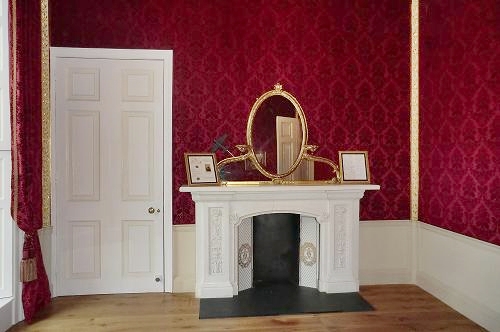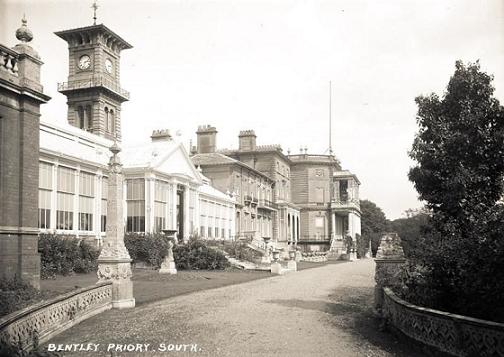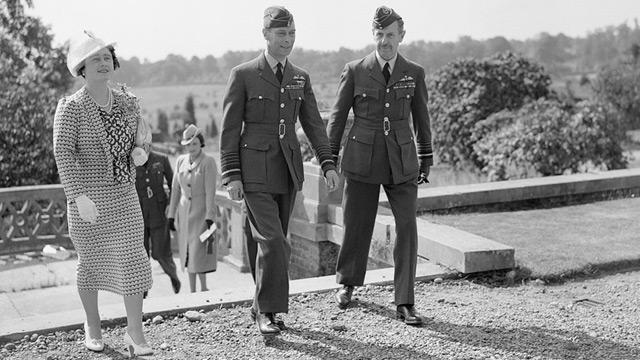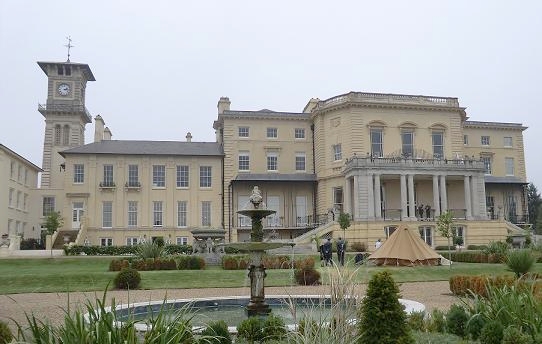Bentley Priory today with the restored Italian Garden in the foreground and the clock tower to the left added by Sir John Kelk. The original priory was built further down the hill where priory house in Clamp Hill is now, and the chapel standing apart on Harrow weald Common. It started life as an Augustinian house attached to the Priory of St Gregory, Canterbury, and owned by Augustan Cannons of Smithfield. The name Bentley comes from the ancient Anglo-Saxon language the prefix bent from the word Beonet, which means a place covered in coarse grass, and the suffix ley from the word Leah, a piece of cleared ground on the uplands. These words imply open space and traditional grassland, which remain a feature of The Bentley Priory Nature Reserve today.
By the time the doomsday book was compiled in 1086 William the Conqueror had invested his own bishop (Lanfrane) with the Archbishoprie of Canterbury and restored the lands appropriated by King Edward to the church. The original priory was the only monastic establishment in the Manor of Harrow, and housed a cell on Augustine Friars. It was founded in 1170 by Ranulf de Glanville who was a lawyer, appointed Chief Justiciar of England in 1180 during the reign of King Henry II, He resigned his office in 1190 to join the crusades. Whilst taking part in the siege of Acre, he gained the unfortunate distinction of being the first English nobleman to be killed on a crusade.
There was not much written about he priory at the time although it was mentioned in Matthew Paris’s chronicle for the year 1248 which describes ‘the miserable death of the Prior of Benethly’ who it seems met his fate when he had been accidentally suffocated after a rick of wheat whose value he had been estimating tottered and fell upon him.
In 1543 the priory was given to Sir Thomas Cramner who promptly exchanged the priory and 329 acres of land with king Henry VIII for land in Wimbledon. In 1546 Henry VIII gave the lands to Robert Needham and William Sacheverell who in the following year transferred them to Elizabeth Cotte. The priory's religious days were over and it passed through various hands until it was ultimately sold in 1766 to James Duberley an army contractor who pulled down the original priory and built a more imposing house on a higher part of the grounds, as he wanted to show off his wealth and importance.
John James Hamilton the 9th earl of Abercorn
In 1788 James Duberley sold off the priory to John James Hamilton the 9th earl of Abercorn. On his elevation in the peerage the following year, to marques he made extensive alterations to the house and park. He commissioned Sir John Soane one of the most pre eminent 18th century architects to extend and refurbish the simple three storey house in a more lavish and sumptuous style. The outside of the present house is largely due to his money and Soanes vision. The refurbishments included a gallery of fine paintings and several large apartments and a grand staircase of Portland stone. The original plans called for a library, and a circular room called a tribune for the display of pictures and statues. Some time later a drawing room, a dining room and a music room followed along with a lavish rectangular entrance hall with Greek Doric pillars which held up the vaulted ceiling. Sir Robert Smirke architect of the British museum, was commissioned later by the marquis to make further alterations.
The marquess lived at the priory like a true nobleman of the day. He was the only man who held peerage titles in all three kingdoms, England Scotland and Ireland. As a result of his influence the priory soon became a rendezvous for many political and literary celebrities including Pitt, Wellington, canning, the poets Wordsworth Moore Campbell and Scott. Sir William and Lady Emma Hamilton who was later the mother of Nelsons illegitimate daughter Horatia, and thespians Mrs Sarah Siddons and John Kemble who were attracted the beautiful surroundings.
Sir Walter Scott became a frequent visitor and spent much of this time in the summerhouse, which was built on an island on the lake writing and revising Marmion. Marmion was an epic poem about the Battle of Flodden Field and it was published in 1808.
Queen Adelaide
In 1846 Queen Adelaide who was widow of William IV leased Bentley Priory, but for health reasons didn't move in until 1848. She had been advised because of her condition to move to Stanmore because of the ‘salubrious air.’ By the time she moved in she was extremely ill with oedema and from her first days there found the stairs too much to cope with. A suite of rooms were prepared for her downstairs on the ground floor. It is here that she would have received her guests including her niece Queen Victoria and Prince Albert. She attended a divine service at he old church in Stanmore and took an interest in the new one. In fact Queen Adelaide's last public appearance was to lay the foundation stone of the church of St John the Evangelist, Great Stanmore. She gave the font and when the church was completed after her death, the east window was dedicated to her memory.
She died during the reign of her niece Queen Victoria on 2 December 1849 just 57 years old, at home in bed in the Priory, and was buried at St. George's Chapel, Windsor.

Sir John Kelk
The next owner was Sir John Kelk, a railway engineer who took possession of the estate in 1853 due to problems with some parts of the land the actual deed of sale did not go through until 1857. This was when some of the land was split up. The farm land south of Stanmore park including Old Church farm was sold off to St. Bartholomew’s hospital. John Kelk added some extra features such as the clock tower which even today is such a distinguished feature of the priory and remodelled the interior on Italianate style of architecture was a distinct 19th-century phase in the history of Classical architecture.
Frederick Gordon
In 1881 the house and grounds were then sold to Frederick Gordon of Bloomsbury Square for £75000. The sale particulars advertised the woodlands and plantations, as well adapted for rearing game, the estate buildings included a gamekeeper’s house. The bailiff’s house stood in clamp hill the home farm with farm buildings was in the park close by and there were cottages for the dairyman and carpenter. There were two lodges on common road three in clamp hill and the church lodge opposite the church and still standing on the corner of old lodge way. An orangery adorned the upper part of the grounds and a deer park. That tradition continues to this day although it has moved to a different position.
Frederick Gordon already had a large hotel empire, but thought his guests might enjoy staying in the country and converted Bentley Priory from an old mansion to a hotel. The Priory opened as a hotel on 6 June 1885. Coaches were provided for guests from Harrow station (Now called Harrow & Wealdstone) and also a coach service from London. Neither of these solutions was ideal so Gordon decided to extend the railway from Harrow Station through to Stanmore, and create the Stanmore branch line This idea would not only benefit Frederick’s hotel but also the village of Great Stanmore.
He made use of the Queen Adelaide royal connection and included in the hotel brochure her summerhouse on the lake. Pictures in the brochure were featured in the ‘Illustrated London news’ and showed the grand conservatory or winter garden a shady avenue of trees an Italian garden, cedar garden and the lake.
Although his hotel business was one of the biggest in the world and was very successful, the priory was never a financial success for Gordon and he turned it into his family home for himself, his wife and their 11 children. The original family home was on the grounds in a house he had built called Glenthorne. The entire estate was sold off after Gordon’s death.

A school for girls
Like a lot of other large mansions around the area Bentley priory became a superlative school for girls which flourished from 1908 to the early 1920’s. The school housed 70 boarders and it was said that there were 20 pianos in separate sound proof rooms. For several years the school prospered as a female preserve. Male staff were required to leave by 21:30 each evening and the gates locked, any male found on the premises after that were politely but firmly removed.
After the great war probably due to the general financial depression the school failed. At the end of the winter term 28 December 1924 the school closed its gates for good.
In 1926 the estate was broken up, with 240 acres sold to a building syndicate, who divided it into lots, enabling Middlesex County Council to purchase 90 acres of land as part of the Green Belt for a public park.
The Air Ministry and Hugh Dowding
The Air Ministry purchased the mansion and 40 acres of land, including the formal gardens for about £25,000. The house became the headquarters of inland area, responsible for training in the ADGB (Air Defence of Great Britain) Organisation. Between 1934 1939 the number of home defence squadrons was scheduled to increase from 42 to 10. Fighter command HQ opened at the priory on July 14 1936 under the command of Stanmore resident Air Chief Marshall Hugh Dowding, who lived nearby in a large house named Montrose. The Observer Corps which had been established in 1925 moved to the priory in 1936 as well to become part of Fighter Command. In the run up to WW2 an underground operations block was built which occupied until 1940. Anti Aircraft Command moved in to Frederick Gordon's house ‘Glenthorne’ in 1939 and adapted the Gordon family crest of a flexed bow and arrow as its crest. During hostilities the underground ops room and filter room were at the heart of the whole system, information from here being filtered around the entire country.

The priory survived the war quite well with nothing worse than a few shattered windows from the blast of a V2 rocket, but was severely damaged by fire in 1947 and had to be restored. By 1974 the house was nearly condemned by the Dept of the Environment because of dry rot. The building was again devastated by fire in 1979. Eventually I was decided to restore the building to its former glory and the work was completed in 1991.
The land purchased by the Middlesex County Council in 1926 was transferred to the GLC, and came into the ownership of The London Borough of Harrow in 1968. The grounds are now maintained as a nature reserve by the Harrow Nature Conservation Forum, a sub-committee of the Harrow Heritage Trust.
The upper rooms have been converted into private apartments, and the lower rooms of the priory have been opened up as a Battle of Britain museum and are open to the public.
